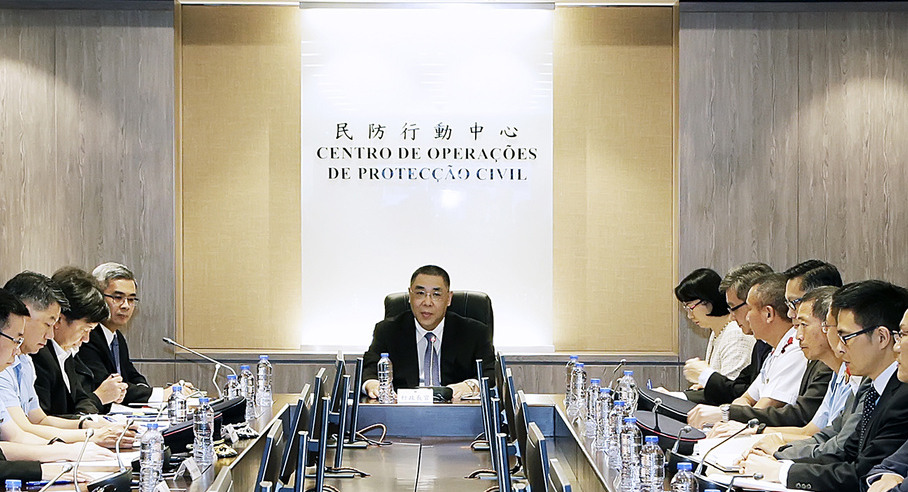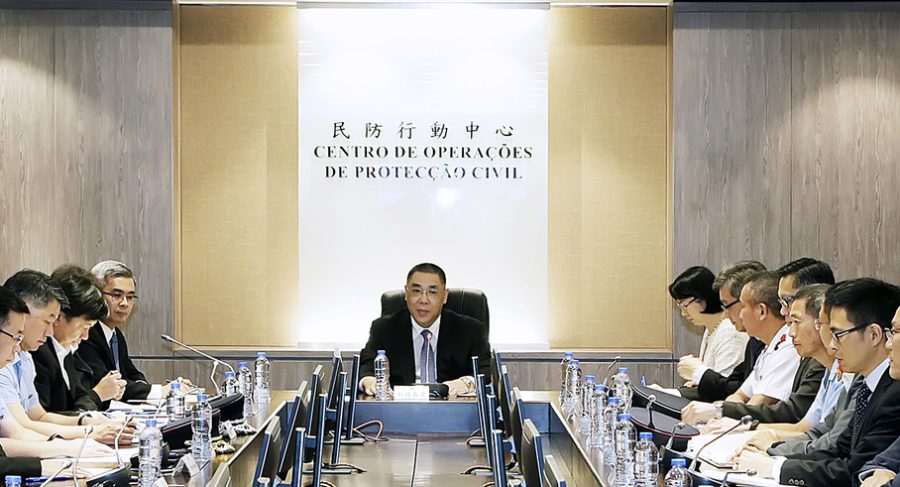Chief Executive Fernando Chui Sai On said Tuesday that the local government will need to carry out a large number of measures with the aim of constantly improving Macau’s ability to tackle typhoons and other major natural disasters.
Chui made the remarks during a specially-convened meeting summarising the government’s measures in preparation for Super Typhoon Mangkhut and its disaster prevention and mitigation tasks.
Chui convened a special meeting yesterday for representatives of all the 29 government entities and private organisations under the government’s civil protection structure to brief him on their respective entities’ measures in responding to Mangkhut.
During the meeting, Chui also listened to opinions and suggestions raised by the representatives about possible amendments to the government’s disaster prevention and mitigation mechanism.
The meeting took place at the Civil Protection Operations Centre – which is located at the Immigration Department Building in Pac On in Taipa.
The 29 entities in the civil protection structure included the city’s various law enforcement agencies, other government entities including the Meteorological and Geophysical Bureau (SMG) and the public Conde de Sao Januario Hospital Centre, as well as several entities involved in civil protection – power utility CEM, telecom operator CTM, Macao Water, Macau Red Cross, Kiang Wu Hospital, government-owned broadcaster TDM, and the company providing management services for Sai Van Bridge.
During the meeting, Chui pointed out that his government has carried out a large number of measures over the past year with the aim of increasing Macau’s disaster prevention and mitigation ability.
Chui stressed that the government has gained “invaluable” experience in tackling disasters resulting from the measures it took in response to Super Typhoon Mangkhut. He also said that the government’s achievements in tackling the menace posed by Mangkhut had highlighted its improved disaster prevention and mitigation ability.
The chief executive said that the local government was yet to carry out numerous measures with the aim of constantly improving the city’s ability to tackle major natural disasters, adding that in this regard there were three major tasks that the government still needed to carry out.
Chui said the first task was to improve Macau’s flood-prevention infrastructure. The second task was to get the construction of a tidal gate project – on the river between the west coast of the Macau peninsula near Barra and Wanzai in Zhuhai – off the ground as soon as possible – a project in collaboration with the mainland authorities, he said.
The third task was to continue strengthening the training of all the government staff involved in civil protection tasks, Chui said.
During the meeting, Chui noted that Mangkhut was so strong that it had an enormous and serious impact on Macau. He said that the local government did its utmost and launched a raft of measures that it had previously prepared with the aim of minimising possible damage and losses caused by the typhoon, adding that the government was determined to ensure the safety of all Macau people.
Chui also praised the professional performance of the civil protection personnel when responding to the Mangkhut threat.
During the meeting, Secretary for Security Wong Sio Chak said that the civil protection personnel had “efficiently” tackled Mangkhut as the chief executive paid close attention to the matter and personally directed the authorities’ typhoon-response tasks. He said that consequently there were no fatalities during Mangkhut’s onslaught.
Wong noted the need for the government to constantly improve its disaster prevention and mitigation measures and tasks.
During Tuesday’s meeting, Unitary Police Service (SPU) Commissioner-General Ma Io Kun reconfirmed that Mangkhut had caused 40 injuries and that 598 incidents and accidents were recorded during its onslaught.
Ma also said that 5,650 people were evacuated from low-lying areas that were hit by serious floods during Sunday’s Mangkhut assault on the city, adding that 1,346 residents and visitors stayed in the 16 emergency shelters provided by the government.
The Social Welfare Bureau (IAS) said in a statement yesterday that 15 emergency shelters were closed at noon on Monday, while the other one was finally closed yesterday at noon.
Wong also said that the public security entities plan to buy additional disaster relief equipment with the aim of further improving their rescue capabilities.






